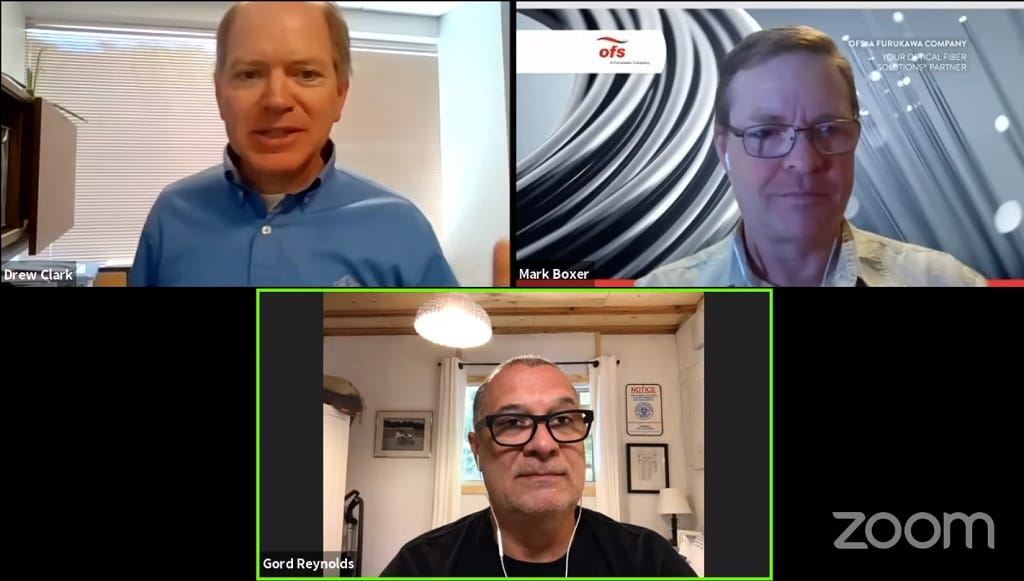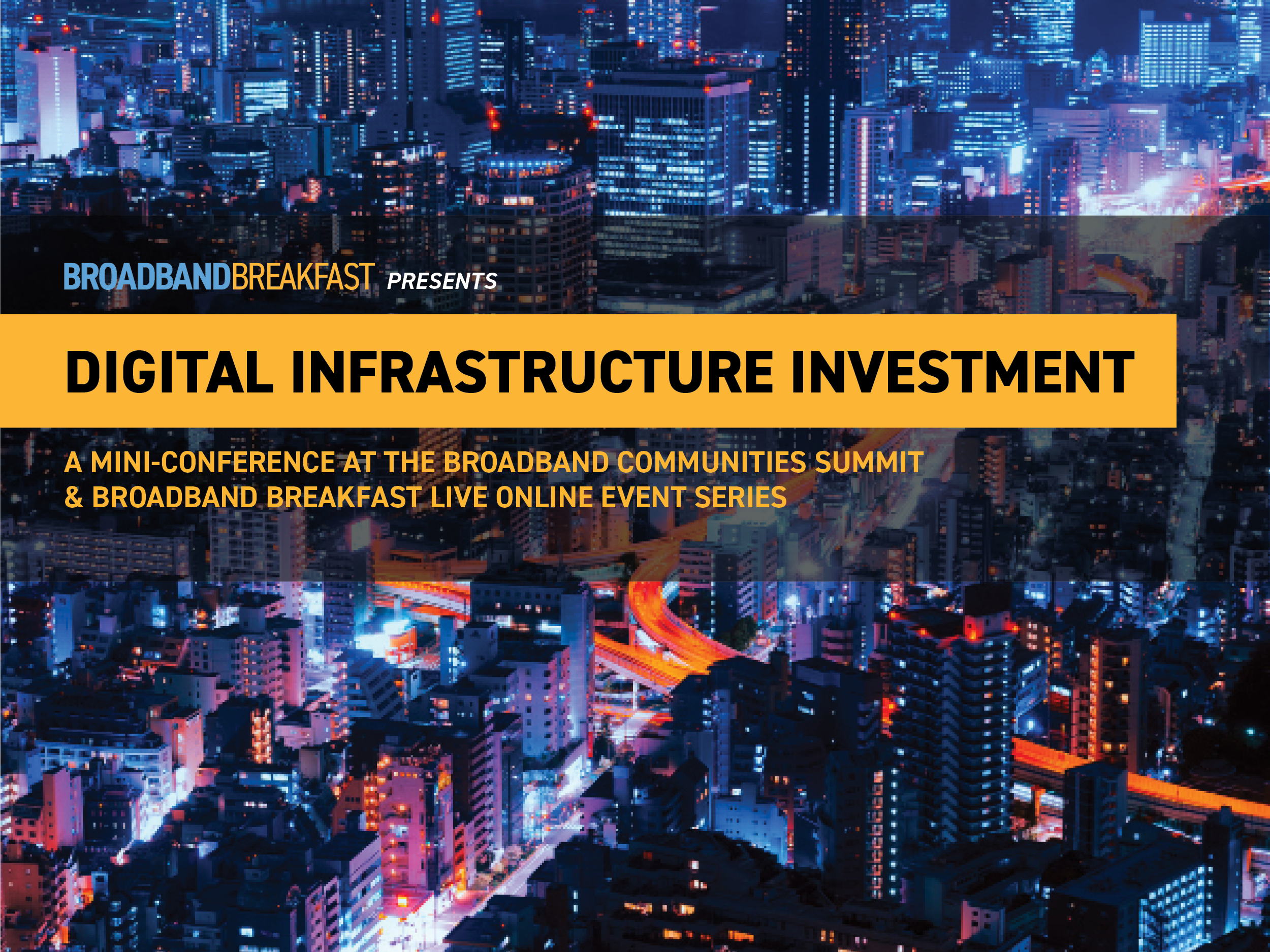Fiber Should Lead Future of Broadband, But Other Technologies Important Compliments
More experts weigh in on the fiber debate, but point to other technologies as important for the future of connectivity.
Benjamin Kahn

June 24, 2021—Fiber will be the definitive technology that will help supply increasing broadband demands in the future, a Broadband Breakfast panel heard Wednesday, but complimentary technologies also play an important role.
Broadband Breakfast hosted experts on both sides of the border – Gord Reynolds from Infrastructure Ontario and Mark Boxer, applications engineering manager for fiber manufacturer OFS – and discussed how physical infrastructure impacts digital infrastructure.
Boxer said that over the next ten years, bandwidth demands will continue to increase, and that ultimately, fiber will be the primary solution to ensuring that consumers can engage in all the behaviors and activities that they want to.
He also argued that wireless technologies should be used to compliment fiber infrastructure rather than an alternative to fiber, adding more fiber means more flexibility with spectrum allocation, while more wireless would lead to less flexibility because there is only so much spectrum, and jurisdictions need to allocate it differently while every stakeholder is vying for more spectrum.
On Tuesday, experts warned Congress that it shouldn’t go all-in on wired infrastructure, partly because those other technologies add redundancy and resiliency to those hard connections.
Discussions over the past several months have been focused increasingly on the importance and prominence of fiber, which many say is the lifeblood of high-quality networks. In March, Republican South Carolina Senators Tim Scott and Lindsey Graham reintroduced the State Fix Act, which would pledge $20 billion for broadband infrastructure using fiber.
Similar sentiment in Canada’s most populous province
Infrastructure Ontario is an agency of the Government of Ontario and is tasked with facilitating public/private partnerships to build everything from hospitals and highways to telecom networks. Reynolds said IO wants to provide at least 50 Mbps download and 10 Mbps upload – the federal objective — in every region of the province, with a penetration between 80 and 90 percent—most which IO plans to connect with wired infrastructure.
Even though wired connections are the goal, Reynolds said the perfect should not become the enemy of the good, and that satellite and fixed wireless technologies need to be a part of the solution for the hardest to reach areas.

Boxer echoed many of the points expressed by Reynolds, stating that the infrastructure that is laid today must be able to handle the consumer demands of tomorrow. He pointed to how much consumer usage has changed in just the past several years.
“In a residence, if you’re using Netflix, and [Microsoft] Teams, and cameras, you have to add that all up,” he said. “And as we start doing that, we are seeing the potential trends for gigabit services that are needed.” (Some have expressed skepticism about whether fixed-wireless technologies can supply gigabit speeds.)
Speeds need updating
As it currently stands, the Federal Communications Commission considers broadband to be anything that is capable of 25 Mbps download and 3 Mbps upload, but Boxer said that in his experience, 25/3 is basically unusable for a family and their pattern of broadband consumption.
“There are so many applications now that use our networks and so many of these applications are using two-way traffic that the higher speed levels become very important,” he said, adding “[OFS has] been on the record in some of the 100/100 proposals that have taken place [to adjust the definition of broadband].”
The Fiber Broadband Association has said that the current speed standard is inadequate, while others have said the speed debate is getting in the way of connecting the un(der)served.
Our Broadband Breakfast Live Online events take place every Wednesday at 12 Noon ET. You can watch the June 23, 2021, event on this page. You can also PARTICIPATE in the current Broadband Breakfast Live Online event. REGISTER HERE.

Wednesday, June 23, 2021, 12 Noon ET — “Roads, Bridges and Broadband: How Physical Infrastructure Impacts Digital Infrastructure”
Though poles and fiber are perhaps the most obvious aspects of infrastructure associate with broadband, telecommunications companies must consider many different features adjacent to broadband. The conversation regarding physical infrastructure begins before telcos can even break ground. Indeed, mapping, “dig once” policies and the physical terrain around roads and towers are all aspects that need to be considered before internet deployment can begin. Join Broadband Breakfast for a session exploring the unique ways that roads, bridges, and other pieces of physical infrastructure shape the deployment of digital infrastructure.
More about Digital Infrastructure Investment 2021 at Broadband Communities Summit
Panelists:
- Mark Boxer, Applications Engineering Manager, OFS Optics
- Gord Reynolds, Vice President of Commercial Advisory & Strategy, Infrastructure Ontario
- Drew Clark (moderator), Editor and Publisher of Broadband Breakfast

Mark Boxer is a Technical, Solutions and Applications Engineering Manager for OFS. In this role, he assists customers deploying fiber in a wide variety of network design scenarios around the world and analyzes trends in telecommunications markets that drive new product innovation. Mark has a BME degree from Georgia Tech, and has spent his 30+ year career in the fiber industry including varied roles in manufacturing and applications engineering for fiber-based products and markets.
Gord Reynolds is currently the Vice President of Commercial Advisory and Strategy at Infrastructure Ontario leading a variety of initiatives to improve utility coordination and accelerate the delivery of broadband across Canada. Prior to this, Gord was the Managing Director of Capgemini’s Canadian Utilities Practice and the Global innovation leader for the Power & Utility sector. He was also a member of Capgemini’s Global Sector Council and spent 8 years as the Global lead for Capgemini’s Smart Energy Services and Digital Utilities Transformation initiatives for the Energy, Utility and Chemicals sector.
Drew Clark, Editor and Publisher of Broadband Breakfast, also serves as Of Counsel to The CommLaw Group. He has helped fiber-based and fixed wireless providers negotiate telecom leases and fiber IRUs, litigate to operate in the public right of way, and argue regulatory classifications before federal and state authorities. In addition to representing public and private providers on broadband issues, Drew is actively involved in issues surrounding interconnected Voice-over-Internet-Protocol service, spectrum licenses, robocalling including STIR/SHAKEN, and the provision of video franchises and “over-the-top” copyrighted content.
WATCH HERE, or on YouTube, Twitter and Facebook.

As with all Broadband Breakfast Live Online events, the FREE webcasts will take place at 12 Noon ET on Wednesday.
SUBSCRIBE to the Broadband Breakfast YouTube channel. That way, you will be notified when events go live. Watch on YouTube, Twitter and Facebook.
See a complete list of upcoming and past Broadband Breakfast Live Online events.










Member discussion